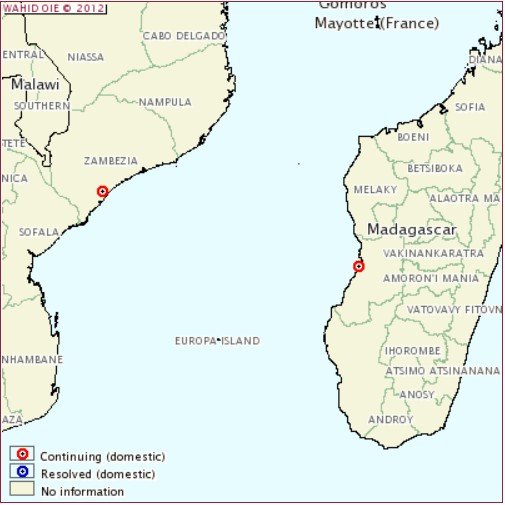White spot disease outbreaks mozambique madagascar WAHIS map
Seven months ago, the Indian Ocean was still known to the shrimp industry as one of the last corners of the planet where producers managed to rear shrimp for more than 20 years without any reported White Spot Disease (WSD) case. The devastating impact of diseases on shrimp farming in Asia and Americas over the past 20 years is well documented. Amongst these diseases WSD is considered the most virulent one, estimated to have cost the world’s shrimp farming industry close to ten billion dollars in lost production.
WSD is usually highly lethal, with cumulative mortality in farmed shrimp reaching 100% within 2 to 7 days post infection (once a pond is affected). The means of transmission of the virus are vertical (trans-ovum), horizontal (oral consumption of infected tissue) and water-borne (in open ponds, the viability of free virus in sea water is 3-4 days). Diseased shrimp show typical clinical signs – although not pathognomonic – such as a dark-reddish coloration of the whole body and white inclusions (spots) on the carapace and appendages, and lethargic behavior with loss of appetite. The causative agent of WSD, i.e. the White Spot Syndrome Virus (WSSV), a double stranded DNA virus (Whispovirus, Nimaviridae), first emerged in Northeast Asia in 1992-1993 and is now geographically widespread. It has a very broad host range (all decapods are sensitive and annelids, arthropods or mollusks can be vectors).
Unfortunately, seven months ago, the first occurrence of WSD in Africa was detected in a shrimp farm located in Quelimane, Zambezia Province, Mozambique (August 31st, 2011). More shrimp aquaculture sites in the country were also diagnosed as WSSV positive later that year 2011. In parallel with the stamping out exercise, an initial rapid epidemiological survey was performed with the contribution of both public and private stakeholders, aimed at assessing the WSSV’s distribution on the Mozambican coast. The first results that were obtained showed that this virus is already widespread in almost all coastal provinces of Mozambique, affecting several crustacean species including penaeid shrimp and crabs, thereby strongly suggesting that WSD has been present in these waters for several months or years. On May 9th, 2012 the second outbreak in the region was reported and confirmed in a semi-intensive shrimp farm in the south-west of Madagascar. The epidemiological survey aimed at pin-pointing the origin of the infection and at assessing WSSV distribution on the Madagascan coast is currently underway.
As a consequence, all affected production units had to be stamped out (i.e. depopulated, dried out and disinfected), leading to huge economic losses and unemployment.
These two recent and unexpected events highlight the importance of developing a national strategy for aquatic animal health and of having a functional general surveillance programme in place, before the first occurrence of an aquatic animal disease, to be prepared for disease prevention, early detection and implementation of an adequate emergency response in case of occurrence.
Given the experience from other countries where this disease became endemic, it is obvious that the traditional farming methods used in Africa will now have to be adapted to this new sanitary situation; this means increasing biosecurity levels in rearing facilities, controlling movements of all susceptible animals and identifying all possible entries of the virus. Working under bio-secure and pre-certified WSSV-free compartments and with quarantined polymerase chain reaction [PCR]-tested wild brood stock (or even better, domesticated specific pathogen free [SPF] shrimp) is the only reliable way known to date to continue producing shrimp in WSSV infected zones. This will require a huge financial effort from the African shrimp industry, along with a strong involvement and supervision by the Competent Authorities supported by focal points of Mozambique, Madagascar and surrounding countries.

